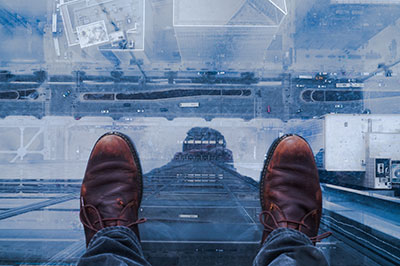 A specific phobia is an anxiety disorder that is characterized by an unreasonable or irrational fear related to exposure to specific objects or situations. As a result, the affected person tends to avoid contact with the objects or situations and, in severe cases, any mention or depiction of them. Specific phobia affects around 12% of people at some point in their life.
A specific phobia is an anxiety disorder that is characterized by an unreasonable or irrational fear related to exposure to specific objects or situations. As a result, the affected person tends to avoid contact with the objects or situations and, in severe cases, any mention or depiction of them. Specific phobia affects around 12% of people at some point in their life.
There are a number of types of phobias and it’s not unusual to experience a specific phobia about more than one object or situation. Specific phobias can also occur along with other types of anxiety disorders. The most common specific phobias include:
- Acrophobia: Fear of heights
- Aerophobia: Fear of flying
- Aquaphobia: Fear of water
- Arachnophobia: Fear of spiders
- Blood, injury, and injection (BII) phobia: Fear of injuries involving blood
- Claustrophobia: Fear of being in constricted, confined spaces
- Driving phobia: Fear of driving a car
- Emetophobia: Fear of vomiting
- Erythrophobia: Fear of blushing
- Escalaphobia: Fear of escalators
- Hypochondria: Fear of becoming ill
- Tunnel phobia: Fear of tunnels
- Zoophobia: Fear of animals
These are far from the only specific phobias. People can develop a phobia about almost anything. Also, as society changes, the list of potential phobias changes. For instance, nomophobia is the fear of being without a cell phone or computer.
In someone with a specific phobia, the fear or anxiety may be triggered both by the presence and the anticipation of the specific object or situation. A person who encounters something they are phobic of will usually show signs of fear or express discomfort. In some cases, it results in a panic attack. In adults, the person may logically know the fear is unreasonable but still find it difficult to control the anxiety. This condition may significantly impair the person’s functioning and even physical health.
A person with a phobia can experience the following symptoms. No matter what specific phobia a person has, it’s likely to produce these types of reactions:
- An immediate feeling of intense fear, anxiety and panic when exposed to or even thinking about the source of the fear
- Awareness that the fear is unreasonable or exaggerated but feeling powerless to control it
- Difficulty functioning normally because of the fear
- Doing everything possible to avoid the object or situation or enduring it with intense anxiety or fear
- Feeling nauseated, dizzy or fainting around blood or injuries
- Physical reactions and sensations, including sweating, rapid heartbeat, tight chest or difficulty breathing
- Worsening anxiety as the situation or object gets closer in time or physical proximity
- In children, possibly tantrums, clinging, crying, or refusing to leave a parent’s side or approach their fear
Complex Phobias
These phobias mostly develop during adulthood and are associated with a deep-rooted fear about a certain situation or circumstance. Sometimes complex phobias continue for years.
A complex phobia is much more likely to affect a person’s wellbeing than a specific phobia. For example, those who experience agoraphobia may also have a number of other phobias that are connected. These can include monophobia (a fear of being left alone) and claustrophobia (a fear of feeling trapped in closed spaces). In severe cases, a person with agoraphobia will rarely leave their home. Complex phobias can be considerably more difficult to treat than simple phobias.
The Cause of Phobias
Much is unknown about the actual cause of specific phobias. They seem to develop as a result of having a negative experience or panic attack related to a specific object or situation. Moreover, there may be a link between a person’s specific phobia and the phobia or anxiety of their parents due to genetics or learned behavior. Research has suggested that changes in brain functioning may play a role in developing specific phobias. For example, a number of studies have found that the amygdala in the brain is associated with the development of a phobia.
Dr. Randi Fredricks, Ph.D.
Author Bio
Dr. Randi Fredricks is a leading expert in the field of mental health counseling and psychotherapy, with over three decades of experience in both research and practice. She holds a PhD from The Institute of Transpersonal Psychology and has published ground-breaking research on communication, mental health, and complementary and alternative medicine. Dr. Fredricks is a best-selling author of books on the treatment of mental health conditions with integrative medicine. Her work has been featured in leading academic journals and is recognized worldwide. She is actively involved in developing innovative solutions for treating mental health. To learn more about Dr. Fredricks’ work, visit her website: https://drrandifredricks.com
References
Bragazzi NL, Puenete GD. (2014). A proposal for including nomophobia in the new DSM-V. Psychology Research and Behavior Management, 7,155-160.
Choy Y, Fyer AJ, Lipsitz, JD. (2007). Treatment of specific phobia in adults. Clinical Psychology Review, 27(3), 266–286.
Emmanuel NP, Brawman-Mintzer O, Morton WA. (2000). Bupropion SR in treatment of social phobia. Depress Anxiety, 12, 111–113.
Öst, Lars-Göran (Ed.), Skaret, Erik (Ed.). (2013). Cognitive Behavioral Therapy for Dental Phobia and Anxiety. Hoboken, NJ: Wiley-Blackwell.
Marks I. (1979). Exposure therapy for phobias and obsessive-compulsive disorders. Hosp Pract, 14(2), 101–108.
Parsons TD, Rizzo AA. (2008). Affective outcomes of virtual reality exposure therapy for anxiety and specific phobias: A meta-analysis. Journal of Behavior Therapy and Experimental Psychiatry, 39(3), 250–261.

